
Minette is a type of mineral deposit, consisting of iron ore of sedimentary origin, found in the south of Luxembourg and in Lorraine. Minette ore was deposited in the Early Jurassic and Middle Jurassic. [1]

Minette is a type of mineral deposit, consisting of iron ore of sedimentary origin, found in the south of Luxembourg and in Lorraine. Minette ore was deposited in the Early Jurassic and Middle Jurassic. [1]
The term "minette" came from French miners. It is a diminutive form of "la mine", and might be translated as "little mine, little colliery" or "little vein", referring to its relatively poor iron content of between 28% and 34%. [2]
In other uses, "minette" is also an archaic rock term used to locally describe a particular type of lamprophyre. [2]
The deposit is one of the largest iron reserves in the world. The reserves have been estimated at 6 billion tons, with an iron content of 2 billion tons. The phosphorus content of Minette rendered its industrial processing impossible for a long time, which changed with the introduction of the Thomas-Gilchrist procedure.
After the Franco-Prussian War of 1870-1871, large parts of Lorraine were annexed by Germany. The borders were determined such that much of the known Minette reserves were in German territory. The geologist Wilhelm Hauchecorne, a member of the border commission, had argued for this. [3] Although the German authorities awarded significantly more mining concessions than the French had, iron ore production hardly increased until 1879. This changed in the 1880s, due to a greater number of railway lines in the Minette area and the construction of a railway line from Thionville in France to Völklingen in Germany, which from 1883 enabled a direct link with the Saarland industrial area. [3] [4] Explorations in the 1880s showed that the Minette reserves reached further to the West than had previously been assumed, and increased in volume and iron content the deeper they went. By 1909, 16 mines had been dug in the French part of Lorraine, the département Meurthe-et-Moselle, especially in the basin of Briey, which mined Minette through mine shafts.
After World War I, Lorraine belonged completely to France again. In 1919, yearly production went over 41 million tons, 21 million tons of these in the département Moselle and 20 million tons in the département Meurthe-et-Moselle. Lorraine was, after the United States, the second-largest iron producer in the world. The high point of ore production was reached with 62 million tons in France and 6 million tons in Luxembourg in 1960. Currently, after 150 years of mining, approximately 3 billion tons of ore have been produced. The relatively low iron content, however, meant that Lotharingian Minette-ore was successively replaced by more highly concentrated imported ores (with iron contents around 60%). As a consequence, more and more mines were closed down. The last pit in Luxembourg, Differdange, closed in 1981, the last French one, at Audun-le-Tiche in the Moselle department did so in 1997.
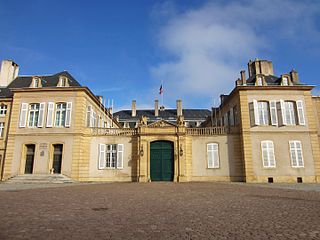
Moselle is the most populous department in Lorraine, in the northeast of France, and is named after the river Moselle, a tributary of the Rhine, which flows through the western part of the department. It had a population of 1,046,543 in 2019. Inhabitants of the department are known as Mosellans.
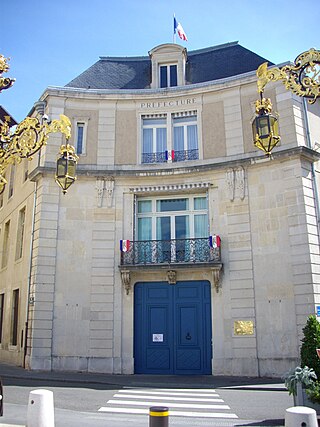
Meurthe-et-Moselle is a department in the Grand Est region of France, named after the rivers Meurthe and Moselle. Its prefecture and largest city is Nancy and it borders the departments of Meuse to the west, Vosges to the south, Moselle and Bas-Rhin and it borders the Belgian province of Luxembourg and the country of Luxembourg by the canton of Esch-sur-Alzette to the north. It had a population of 733,760 in 2019.

Longwy is a commune in the French department of Meurthe-et-Moselle, Lorraine, administrative region of Grand Est, northeastern France.

Lorraine is a cultural and historical region in Northeastern France, now located in the administrative region of Grand Est. Its name stems from the medieval kingdom of Lotharingia, which in turn was named after either Emperor Lothair I or King Lothair II. Lorraine later was ruled as the Duchy of Lorraine before the Kingdom of France annexed it in 1766.
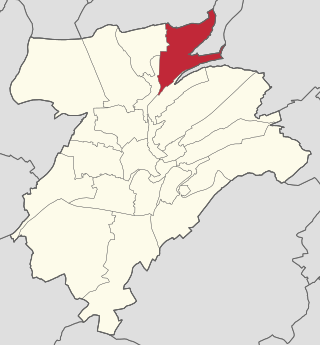
Dommeldange is a quarter in north-eastern Luxembourg City, in southern Luxembourg.

Mining in Iran is still under development, yet the country is one of the most important mineral producers in the world, ranked among 15 major mineral-rich countries, holding some 68 types of minerals, 37 billion tonnes of proven reserves and more than 57 billion tonnes of potential reserves worth $770 billion in 2014. Mineral production contributes only 0.6 percent to the country's GDP. Add other mining-related industries and this figure increases to just four percent (2005). Many factors have contributed to this, namely lack of suitable infrastructure, legal barriers, exploration difficulties, and government control.

Mining in Brazil is centered on the extraction of iron, copper, gold, aluminum, manganese, tin, niobium, and nickel. About gemstones, Brazil is the world's largest producer of amethyst, topaz, agate and is a big producer of tourmaline, emerald, aquamarine, garnet and opal.

Marbache is a commune in the Meurthe-et-Moselle department in northeastern France.

Although the subsoil of Ivory Coast contained many other minerals, none existed in commercially exploitable amounts, given the high costs of extraction. Mining contributed only 1 percent of GDP in 1986.
The mineral industry of Russia is one of the world's leading mineral industries and accounts for a large percentage of the Commonwealth of Independent States' production of a range of mineral products, including metals, industrial minerals, and mineral fuels. In 2005, Russia ranked among the leading world producers or was a significant producer of a vast range of mineral commodities, including aluminum, arsenic, cement, copper, magnesium compounds and metals, nitrogen, palladium, silicon, nickel and vanadium.
Mining in North Korea is important to the country's economy. North Korea is naturally abundant in metals such as magnesite, zinc, tungsten, and iron; with magnesite resources of 6 billion tonnes, particularly in the North and South Hamgyong Province and Chagang Province. However, often these cannot be mined due to the acute shortage of electricity in the country, as well as the lack of proper tools to mine these materials and an antiquated industrial base. Coal, iron ore, limestone, and magnesite deposits are larger than other mineral commodities. Mining joint ventures with other countries include China, Canada, Egypt, and South Korea.

In the industrial sector, the Luxembourg steel industry continues to occupy the first place in the country, even after the industrial reforms which have taken place since the 1960s.

Adrien Charles Joseph Robert de Wendel d'Hayange, often known as Robert de Wendel, was a French steelmaker, heir of a long line of Lorraine industrialists. He and his brother Henri ran several large steelworks in Lorraine. From 1898 until his accidental death in 1903 he was president of the Comité des forges, the French steelmakers' association.

Camille Cavallier was a French industrialist who directed the Pont-à-Mousson iron works in Lorraine in the first quarter of the 20th century, specializing in making cast iron pipes. He came from a poor family but obtained a good technical education and joined the iron maker as an employee in 1874. He rose rapidly through the ranks, and started to acquire shares. Soon after taking charge of the company he became the largest shareholder. He quadrupled production in the years leading up to World War I (1914–18). The company was devastated by the war, but Cavallier managed to bring production back up to prewar levels before his death.
The Comptoir Métallurgique de Longwy was a cartel of iron smelters seated in Longwy, a town in Lorraine, department Meurthe-et-Moselle, France. In a narrower sense of the term, the ‘Comptoir de Longwy’ was only the ‘’sales agency’’ of the respectively underlying cartel, which also enclosed its member firms and possible other cartel organs. As a legal entity, the Comptoir Métallurgique de Longwy existed from December 10, 1876, to February 1, 1921. It should not be mixed up with the Aciéries de Longwy, which was temporarily a member firm of the cartel not earlier than 1880 and survived the cartel up to 1978.
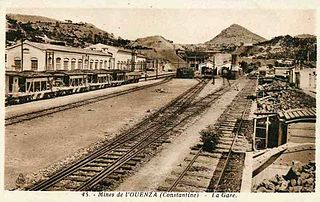
The Société de l'Ouenza was an Algerian iron ore mining company founded in 1913 and nationalized in 1966. It exploited rich deposits of high-quality ore at two sites in northeast Algeria near the Tunisian border. The ore was sent by rail to the port of Bône, then shipped to refineries in the UK, Europe and North America. At its peak it employed 4,000 workers who were housed in company towns.

The geology of Luxembourg is divided into two geologic regions: Rheinisches Schiefergeblige in the north, extending into the Ardennes region in Belgium, and the Oesling Zone to the north of Ettelbruck. The country is underlain by the Hercynian orogeny related Givonne Anticlinorium, which mainly contains Early Devonian sandstone and shale. Rocks closer to the surface are primarily from the Cretaceous and are cut by the Sauer River and its tributaries.
The International Steel Agreement was instituted in 1926 in Europe and was the first international steel cartel. Its purpose was to sustain prices, and to equitably divide up quotas amongst member states and companies, which represented around two-thirds of the world's steel exports, as well as to secure the member states' supplies of iron ore and coke, which were indispensable to their steel industries. It faced difficulties due to Nazi Germany's desire to re-arm and increased British and American exports after the Wall Street Crash of 1929.

Mining in France is based solely on the nature of the material, whether extracted from the surface or underground. These include fuels, metals and a few other minerals.
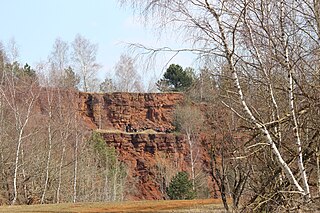
Mining in Luxembourg mostly refers to the extraction of iron ores, known as Minette. Iron-ore mining, both open-pit and underground, had significant economic and political importance in Luxembourg for an entire century, especially from the second half of the 19th century onwards. This was especially the case after modern technology made it possible to make use of the oolitic iron ores found in the region for iron and steel production. These iron ores were already known during Roman times, but the technological capabilities to exploit them did not yet exist.